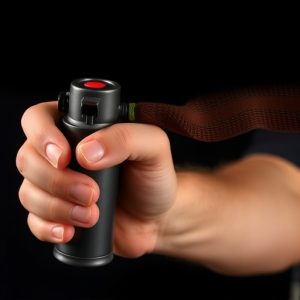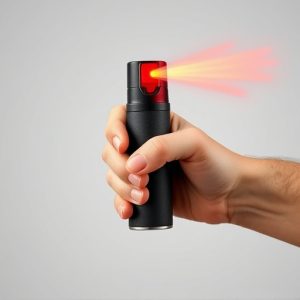Pocket-Sized Defense: A Comprehensive Guide to Pepper Spray Laws and Safety
Pepper spray, a non-lethal defense tool using capsaicin from chili peppers, temporarily disables att…….
Pepper spray, a non-lethal defense tool using capsaicin from chili peppers, temporarily disables attackers but its effectiveness varies based on distance, weather, and attacker's clothing. Due to differing US state laws regarding possession, use, and carry locations, thorough research of Pepper Spray Laws by State is crucial before considering it as a personal defense mechanism for legal compliance and maximized utility. Pocket-sized devices with high capsaicin concentrations, easy carrying clips, quick triggers, and glow-in-the-dark options enhance usability. Always check local laws, understand your spray's features, store it safely, and aim for the face in an emergency for maximum effectiveness.
“Uncover the power of pocket-sized personal defense with our comprehensive guide. In today’s world, knowing how to protect yourself is essential. We explore the versatile pepper spray device, its mechanisms, and why it’s a must-have for self-defense. From understanding its active ingredient to navigating Pepper Spray Laws by State, this article covers everything you need to know. Learn about the benefits, safety practices, and legal considerations, empowering you to make an informed decision.”
- Understanding Pepper Spray: What It Is and How It Works
- Pocket-Sized Personal Defense Spray: Features and Benefits
- Pepper Spray Laws by State: A Comprehensive Guide
- Safety Considerations and Best Practices for Carrying Pepper Spray
Understanding Pepper Spray: What It Is and How It Works
Pepper spray, also known as oleoresin capsicum (OC) spray, is a non-lethal personal defense tool designed to temporarily incapacitate an attacker. It’s a liquid or aerosol compound derived from the peppers used in cooking, containing capsaicin, the chemical responsible for its pungent and burning sensation. When sprayed, it irritates the eyes, nose, throat, and skin, causing temporary blindness, coughing, and difficulty breathing. This disruption is enough to create an escape route or allow for further defensive actions.
The effectiveness of pepper spray varies based on factors like distance, weather conditions, and the attacker’s clothing. Despite its popularity, understanding Pepper Spray Laws by State is crucial before considering it as a personal defense mechanism. These laws dictate who can possess pepper spray, where it can be carried, and under what circumstances it can be used, varying significantly across different states in the US. It’s essential to research these regulations thoroughly to ensure compliance and maximize its utility in case of need.
Pocket-Sized Personal Defense Spray: Features and Benefits
Pocket-sized personal defense spray devices have become increasingly popular as a convenient and effective means of self-protection. These compact sprays are designed to fit comfortably in your pocket, bag, or even purse, making them easily accessible when you need them most. A key feature is their potency; they typically contain high concentrations of capsaicin, the active ingredient responsible for the burning sensation in chili peppers, which can incapacitate an attacker temporarily.
Beyond their compact size and powerful formula, these devices offer several benefits. Many models come with a range of features like a built-in clip for easy carrying, a simple trigger mechanism for quick deployment, and even glow-in-the-dark options for better visibility in dark situations. Additionally, understanding local Pepper Spray Laws by State is crucial before purchasing; regulations vary widely, ensuring compliance keeps you legally protected while providing peace of mind.
Pepper Spray Laws by State: A Comprehensive Guide
The legal landscape surrounding pepper spray in the United States varies significantly from state to state, with each having its own set of regulations and restrictions on the possession and use of this personal defense device. Understanding these Pepper Spray Laws by State is crucial for anyone considering carrying a spray as a form of self-protection. These laws cover aspects like age restrictions, permit requirements, and permissible places for carry.
For instance, some states allow pepper spray without a permit, while others mandate individuals obtain a special license or permit before purchasing and carrying it. Additionally, there are varying restrictions on the concentration of capsaicin (the active ingredient in pepper spray) permitted for personal use. Some states have also established specific no-carry zones where pepper spray is strictly prohibited, such as schools, government buildings, or certain public venues. Knowing and adhering to these Pepper Spray Laws by State is essential for ensuring compliance with local regulations and maximizing the safety benefits of carrying a personal defense spray device.
Safety Considerations and Best Practices for Carrying Pepper Spray
Carrying a pepper spray device for personal defense is a significant responsibility that comes with crucial safety considerations. It’s essential to understand local Pepper Spray Laws by State, as regulations vary widely. Always ensure you have a valid reason and permit, if required, for carrying pepper spray in public spaces. Familiarize yourself with the type of pepper spray you possess; different concentrations and delivery mechanisms exist, each with its effectiveness and range.
Best practices include keeping the device easily accessible yet secure in your pocket or bag. Ensure it’s well-maintained, with a clear view of the nozzle and no obstructions. Regularly check expiration dates, as pepper spray can degrade over time. In an emergency, aim for the face—eyes, nose, and mouth—for maximum impact while minimizing collateral damage. Practice safe storage at home, out of reach of children and pets.
In conclusion, a pocket-sized personal defense spray can be a powerful tool for individuals seeking to protect themselves in various situations. Understanding both its operation and the legal framework surrounding pepper spray across different states is essential. By familiarizing yourself with local Pepper Spray Laws by State and practicing safe carrying habits, you can ensure this device enhances your safety without causing harm. Remember, proper knowledge and responsible use are key when considering any personal defense tool.


